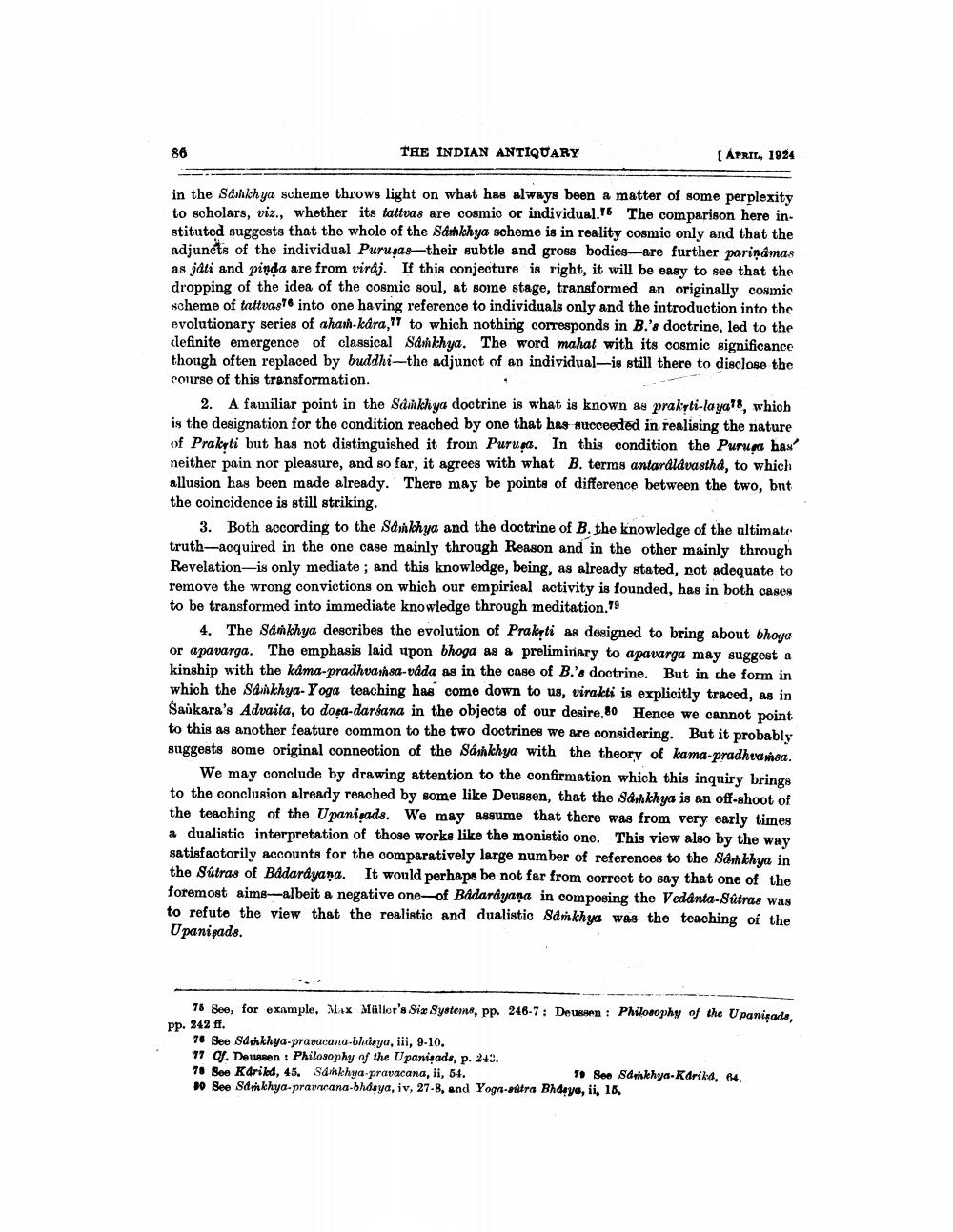________________
THE INDIAN ANTIQUARY
APRIL, 1924
in the Sankhya scheme throws light on what has always been a matter of some perplexity to scholars, viz., whether its tattvas are cosmio or individual.T6 The comparison here in stituted suggests that the whole of the Sankhya scheme is in reality cosmic only and that the adjuncts of the individual Purunas-their subtle and gross bodies are further parindmas as jati and pinda are from viraj. If this conjecture is right, it will be easy to see that the dropping of the idea of the cosmic soul, at some stage, transformed an originally cosmic scheme of tattvasi into one having reference to individuals only and the introduction into the evolutionary series of ahash-kara," to which nothing corresponds in B.'s doctrine, led to the definite emergence of classical Sashkhya. The word mahal with its cosmic significance though often replaced by buddhi-the adjunct of an individual-is still there to disclose the course of this transformation.
2. A familiar point in the Sainkhya doctrine is what is known as prakyti-laya78, which in the designation for the condition reached by one that has succeeded in realising the nature of Prakerti but has not distinguished it froin Purusa. In this condition the Puruna han neither pain nor pleasure, and so far, it agrees with what B. terms antaraldvastha, to which allusion has been made already. There may be points of difference between the two, but the coincidence is still striking.
3. Both according to the Sankhya and the doctrine of B. the knowledge of the ultimate truth-acquired in the one case mainly through Reason and in the other mainly through Revelation-is only mediate ; and this knowledge, being, as already stated, not adequate to remove the wrong convictions on which our empirical activity is founded, has in both cases to be transformed into immediate knowledge through meditation.79
4. The Samkhya describes the evolution of Prakyti as designed to bring about bhoya or apavarga. The emphasis laid upon bhoga as a preliminary to apavarga may suggest a kinship with the kama-pradhvanhaa-vada as in the case of B.'s doctrine. But in the form in which the Sainkhya-Yoga teaching has come down to us, virakti is explicitly traced, as in Saukara's Advaita, to doxa-darsana in the objects of our desire,80 Hence we cannot point to this as another feature common to the two doctrines we are considering. But it probably suggests some original conneotion of the Sankhya with the theory of kama-pradhansa.
We may conclude by drawing attention to the confirmation which this inquiry bringe to the conclusion already reached by some like Deusgen, that the Sanhkhya is an off-shoot of the teaching of the Upanigads. We may assume that there was from very early times a dualistic interpretation of those works like the monistio one. This view also by the way satisfactorily accounts for the comparatively large number of references to the Sanhkhya in the Satras of Badardyana. It would perhaps be not far from correct to say that one of the foremost aims-albeit a negative one-of Badardyana in composing the Vedanta-Sutras was to refuto the view that the realistic and dualistic Samkhya was the teaching of the Upanipads.
78 Soo, for example, Max Mallor's Six Systems, pp. 246-7: Deum : Philosophy of the Upanixade. pp. 242 ff.
76 See Samkhya-pravacana-bhdaya, iii, 9-10. 77 . Deussen : Philosophy of the Upaniyads, p. 243. 71 Soe Karild, 45. Samkhya pravacana, ii, 54.
See Samkhya-Kdrika, 64. H0 Bee Sdniekhya-pravcana-bhasya, iv, 27-8, and Yogn-dira Bhdeya, ii, 18.




